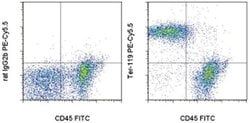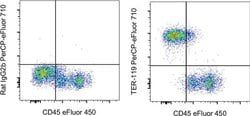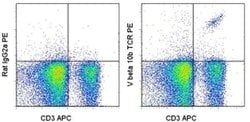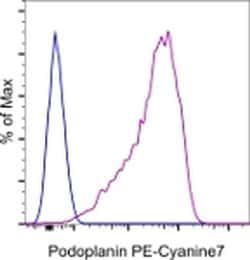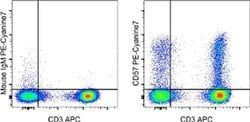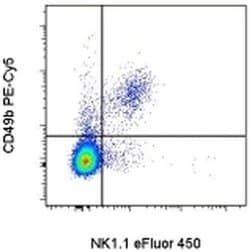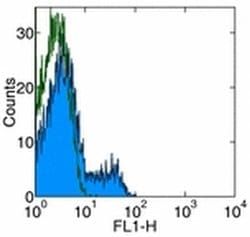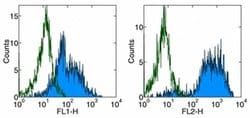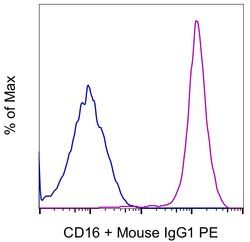50-112-2933
CD49b (Integrin alpha 2) Monoclonal Antibody (DX5), PE-Cyanine5, eBioscience™, Invitrogen™
Manufacturer: Invitrogen
Select a Size
| Pack Size | SKU | Availability | Price |
|---|---|---|---|
| Each of 1 | 50-112-2933-Each-of-1 | In Stock | ₹ 28,836.00 |
50-112-2933 - Each of 1
In Stock
Quantity
1
Base Price: ₹ 28,836.00
GST (18%): ₹ 5,190.48
Total Price: ₹ 34,026.48
Antigen
CD49b (Integrin alpha 2)
Classification
Monoclonal
Concentration
0.2 mg/mL
Formulation
PBS with 0.09% sodium azide; pH 7.2
Gene Accession No.
Q62469
Gene Symbols
Itga2
Purification Method
Affinity chromatography
Regulatory Status
RUO
Gene ID (Entrez)
16398
Content And Storage
4° C, store in dark, DO NOT FREEZE!
Form
Liquid
Applications
Flow Cytometry
Clone
DX5
Conjugate
PE-Cyanine5
Gene
Itga2
Gene Alias
BR, CD49B, GPIa, VLA-2, VLAA2, ITGA2
Host Species
Rat
Quantity
100 μg
Primary or Secondary
Primary
Target Species
Mouse
Product Type
Antibody
Isotype
IgM κ
Description
- Description: The DX5 monoclonal antibody reacts with CD49b, an antigen expressed on a majority of mouse natural killer cells and a subset of T cells
- DX5 reacts with all strains of mouse tested including the most commonly used strains, BALB/c, C57BL/6, C3H, CBA, DBA, AKR, SJL and 129
- Simultaneous staining of C57BL/6 spleen cells with anti-NK1.1 mAb (PK136) and DX5 reveals coexpression of both markers by a majority of cells as well as presence of small populations of DX5+PK136- and DX5-PK136+ cells
- Applications Reported: This DX5 antibody has been reported for use in flow cytometric analysis
- Applications Tested: This DX5 antibody has been tested by flow cytometric analysis of mouse splenocytes
- This can be used at less than or equal to 0.125 μg per test
- A test is defined as the amount (μg) of antibody that will stain a cell sample in a final volume of 100 μL
- Cell number should be determined empirically but can range from 10^5 to 10^8 cells/test
- It is recommended that the antibody be carefully titrated for optimal performance in the assay of interest
- Light sensitivity: This tandem dye is sensitive photo-induced oxidation
- Please protect this vial and stained samples from light
- Fixation: Samples can be stored in IC Fixation Buffer (cat
- 00-8222) (100 μL cell sample + 100 μL IC Fixation Buffer) or 1-step Fix/Lyse Solution (cat
- 00-5333) for up to 3 days in the dark at 4°C with minimal impact on brightness and FRET efficiency/compensation
- Some generalizations regarding fluorophore performance after fixation can be made, but clone specific performance should be determined empirically
- Excitation: 488-561 nm; Emission: 667 nm; Laser: Blue Laser, Green Laser, Yellow-Green Laser
- Filtration: 0.2 μm post-manufacturing filtered
- CD49b (Integrin alpha 2, Integrin alpha 2 chain, VLA-2 alpha chain, HM alpha 2) is a member of the integrin family
- It is a glycoprotein with molecular weight of 150 kD, and it complexes with CD29 (Integrin beta 1) to form the heterodimeric integrin VLA-2 (integrin alpha 2 beta 1, or GPIa/IIa) complex
- VLA-2 is an extracellular receptor for laminin, collagen, and fibronectin, and interaction with its ligands results in the activation of intracellular signaling pathways
- It has reported roles in VEGF-induced angiogenesis in vivo, as well as adhesion and lymphocyte activation
- CD49b is expressed by NK cells, NK-T cells, monocytes, platelets, and epithelial cells
- It is also expressed on adaptive immune cells such as T and B cells, specifically on a subset of CD4+ T cells in the spleen, on intraepithelial and lamina propria lymphocytes in the intestine, as well as on a population of peripheral CD4+ type 1 T regulatory (Tr1) cells that co-express LAG-3.
Compare Similar Items
Show Difference
Antigen: CD49b (Integrin alpha 2)
Classification: Monoclonal
Concentration: 0.2 mg/mL
Formulation: PBS with 0.09% sodium azide; pH 7.2
Gene Accession No.: Q62469
Gene Symbols: Itga2
Purification Method: Affinity chromatography
Regulatory Status: RUO
Gene ID (Entrez): 16398
Content And Storage: 4° C, store in dark, DO NOT FREEZE!
Form: Liquid
Applications: Flow Cytometry
Clone: DX5
Conjugate: PE-Cyanine5
Gene: Itga2
Gene Alias: BR, CD49B, GPIa, VLA-2, VLAA2, ITGA2
Host Species: Rat
Quantity: 100 μg
Primary or Secondary: Primary
Target Species: Mouse
Product Type: Antibody
Isotype: IgM κ
Antigen:
CD49b (Integrin alpha 2)
Classification:
Monoclonal
Concentration:
0.2 mg/mL
Formulation:
PBS with 0.09% sodium azide; pH 7.2
Gene Accession No.:
Q62469
Gene Symbols:
Itga2
Purification Method:
Affinity chromatography
Regulatory Status:
RUO
Gene ID (Entrez):
16398
Content And Storage:
4° C, store in dark, DO NOT FREEZE!
Form:
Liquid
Applications:
Flow Cytometry
Clone:
DX5
Conjugate:
PE-Cyanine5
Gene:
Itga2
Gene Alias:
BR, CD49B, GPIa, VLA-2, VLAA2, ITGA2
Host Species:
Rat
Quantity:
100 μg
Primary or Secondary:
Primary
Target Species:
Mouse
Product Type:
Antibody
Isotype:
IgM κ
Antigen: CD3
Classification: Monoclonal
Concentration: 1 mg/mL
Formulation: PBS with no preservative; pH 7.2
Gene Accession No.: P04235, P11942, P22646, P24161
Gene Symbols: Cd247, Cd3d, CD3E, CD3g
Purification Method: Affinity chromatography
Regulatory Status: RUO
Gene ID (Entrez): 12500, 12501, 12502, 12503
Content And Storage: 4° C
Form: Liquid
Applications: Flow Cytometry, Functional Assay
Clone: 17A2
Conjugate: Functional Grade
Gene: CD3g
Gene Alias: 4930549J05Rik; A430104F18Rik; AI504783; antigen CD3D, delta polypeptide (TiT3 complex); antigen CD3E, epsilon polypeptide (TiT3 complex); antigen CD3G, gamma polypeptide; antigen CD3Z, zeta polypeptide; AW552088; Cd247; CD247 antigen; CD247 antigen, zeta subunit; Cd247 molecule; CD3; CD3 antigen delta chain; CD3 antigen delta polypeptide; CD3 antigen gamma chain; CD3 antigen, delta polypeptide; CD3 antigen, delta subunit; CD3 antigen, epsilon polypeptide; CD3 antigen, gamma polypeptide; CD3 antigen, zeta polypeptide; CD3 delta; CD3 epsilon; CD3 epsilon chain; CD3 epsilon subunit; CD3 epsilon subunit precursor; CD3 gamma-chain; CD3 glycoprotein; CD3 glycoprotein precursor; CD3 molecule delta polypeptide; CD3 molecule, delta; CD3 molecule, epsilon; CD3 molecule, epsilon polypeptide; CD3 molecule, gamma; CD3 molecule, gamma polypeptide; CD3 protein; CD3 TCR complex; CD3 type I transmembrane glycoprotein; CD3 type I transmembrane glycoprotein precursor; CD3 zeta chain; Cd3d; CD3D antigen delta; CD3D antigen, delta polypeptide (TiT3 complex); CD3d molecule; CD3d molecule, delta (CD3-TCR complex); CD3-DELTA; Cd3e; CD3E antigen, epsilon polypeptide; CD3E antigen, epsilon polypeptide (TiT3 complex); CD3e molecule; CD3e molecule, epsilon (CD3-TCR complex); CD3epsilon; CD3-epsilon; Cd3-eta; Cd3g; CD3G antigen, gamma polypeptide; CD3g antigen, gamma polypeptide (TiT3 complex); CD3g molecule; CD3g molecule, epsilon (CD3-TCR complex); CD3g molecule, gamma (CD3-TCR complex); CD3-GAMMA; Cd3h; CD3Q; Cd3z; CD3Z antigen, zeta polypeptide (TiT3 complex); Cd3zeta; Cd3-zeta; CD3zeta chain; CD3-zeta/eta; Ctg3; Ctg-3; FLJ18683; IMD17; IMD18; IMD19; IMD25; Leu-4; OKT3, delta chain; T cell antigen receptor complex epsilon subunit of T3; T3/TCR complex; T3d; T3e; T3g; T3Z; T-cell antigen receptor complex, epsilon subunit of T3; T-cell antigen receptor complex, gamma subunit of T3; T-cell antigen receptor complex, zeta subunit of CD3; T-cell receptor CD3 epsilon chain; T-cell receptor CD3 epsilon subunit; T-cell receptor CD3 subunit zeta; T-cell receptor CD3, subunit zeta; T-cell receptor T3 delta chain; T-cell receptor T3 eta chain; T-cell receptor T3 gamma chain; T-cell receptor T3 zeta chain; T-cell receptor zeta chain; T-cell surface antigen T3/Leu-4 epsilon chain; T-cell surface glycoprotein CD3 delta chain; T-cell surface glycoprotein CD3 epsilon chain; T-cell surface glycoprotein CD3 gamma chain; T-cell surface glycoprotein CD3 zeta chain; T-cell surface protein; TcR CD3 delta-chain; TcR CD3 gamma-chain; TCR zeta chain; TCR zeta chain subunit; TCRE; Tcrk; TCRZ; TCRzeta; TiT3 complex; type I transmembrane protein; T-cell surface molecule CD3
Host Species: Rat
Quantity: 1 mg
Primary or Secondary: Primary
Target Species: Mouse
Product Type: Antibody
Isotype: IgG2b κ
Antigen:
CD3
Classification:
Monoclonal
Concentration:
1 mg/mL
Formulation:
PBS with no preservative; pH 7.2
Gene Accession No.:
P04235, P11942, P22646, P24161
Gene Symbols:
Cd247, Cd3d, CD3E, CD3g
Purification Method:
Affinity chromatography
Regulatory Status:
RUO
Gene ID (Entrez):
12500, 12501, 12502, 12503
Content And Storage:
4° C
Form:
Liquid
Applications:
Flow Cytometry, Functional Assay
Clone:
17A2
Conjugate:
Functional Grade
Gene:
CD3g
Gene Alias:
4930549J05Rik; A430104F18Rik; AI504783; antigen CD3D, delta polypeptide (TiT3 complex); antigen CD3E, epsilon polypeptide (TiT3 complex); antigen CD3G, gamma polypeptide; antigen CD3Z, zeta polypeptide; AW552088; Cd247; CD247 antigen; CD247 antigen, zeta subunit; Cd247 molecule; CD3; CD3 antigen delta chain; CD3 antigen delta polypeptide; CD3 antigen gamma chain; CD3 antigen, delta polypeptide; CD3 antigen, delta subunit; CD3 antigen, epsilon polypeptide; CD3 antigen, gamma polypeptide; CD3 antigen, zeta polypeptide; CD3 delta; CD3 epsilon; CD3 epsilon chain; CD3 epsilon subunit; CD3 epsilon subunit precursor; CD3 gamma-chain; CD3 glycoprotein; CD3 glycoprotein precursor; CD3 molecule delta polypeptide; CD3 molecule, delta; CD3 molecule, epsilon; CD3 molecule, epsilon polypeptide; CD3 molecule, gamma; CD3 molecule, gamma polypeptide; CD3 protein; CD3 TCR complex; CD3 type I transmembrane glycoprotein; CD3 type I transmembrane glycoprotein precursor; CD3 zeta chain; Cd3d; CD3D antigen delta; CD3D antigen, delta polypeptide (TiT3 complex); CD3d molecule; CD3d molecule, delta (CD3-TCR complex); CD3-DELTA; Cd3e; CD3E antigen, epsilon polypeptide; CD3E antigen, epsilon polypeptide (TiT3 complex); CD3e molecule; CD3e molecule, epsilon (CD3-TCR complex); CD3epsilon; CD3-epsilon; Cd3-eta; Cd3g; CD3G antigen, gamma polypeptide; CD3g antigen, gamma polypeptide (TiT3 complex); CD3g molecule; CD3g molecule, epsilon (CD3-TCR complex); CD3g molecule, gamma (CD3-TCR complex); CD3-GAMMA; Cd3h; CD3Q; Cd3z; CD3Z antigen, zeta polypeptide (TiT3 complex); Cd3zeta; Cd3-zeta; CD3zeta chain; CD3-zeta/eta; Ctg3; Ctg-3; FLJ18683; IMD17; IMD18; IMD19; IMD25; Leu-4; OKT3, delta chain; T cell antigen receptor complex epsilon subunit of T3; T3/TCR complex; T3d; T3e; T3g; T3Z; T-cell antigen receptor complex, epsilon subunit of T3; T-cell antigen receptor complex, gamma subunit of T3; T-cell antigen receptor complex, zeta subunit of CD3; T-cell receptor CD3 epsilon chain; T-cell receptor CD3 epsilon subunit; T-cell receptor CD3 subunit zeta; T-cell receptor CD3, subunit zeta; T-cell receptor T3 delta chain; T-cell receptor T3 eta chain; T-cell receptor T3 gamma chain; T-cell receptor T3 zeta chain; T-cell receptor zeta chain; T-cell surface antigen T3/Leu-4 epsilon chain; T-cell surface glycoprotein CD3 delta chain; T-cell surface glycoprotein CD3 epsilon chain; T-cell surface glycoprotein CD3 gamma chain; T-cell surface glycoprotein CD3 zeta chain; T-cell surface protein; TcR CD3 delta-chain; TcR CD3 gamma-chain; TCR zeta chain; TCR zeta chain subunit; TCRE; Tcrk; TCRZ; TCRzeta; TiT3 complex; type I transmembrane protein; T-cell surface molecule CD3
Host Species:
Rat
Quantity:
1 mg
Primary or Secondary:
Primary
Target Species:
Mouse
Product Type:
Antibody
Isotype:
IgG2b κ
Antigen: CD11b
Classification: Monoclonal
Concentration: 1 mg/mL
Formulation: PBS with no preservative; pH 7.2
Gene Accession No.: P05555
Gene Symbols: ITGAM
Purification Method: Affinity chromatography
Regulatory Status: RUO
Gene ID (Entrez): 16409
Content And Storage: 4° C
Form: Liquid
Applications: Flow Cytometry, Functional Assay, Immunohistochemistry (Frozen), Neutralization
Clone: M1/70
Conjugate: Functional Grade
Gene: ITGAM
Gene Alias: antigen CD11b (p170); antigen CD11b (p170); macrophage antigen alpha polypeptide; CD11 antigen-like family member B; CD11b; CD11B (p170); CD11b/CD18; cell surface glycoprotein MAC-1 alpha subunit; cell surface glycoprotein MAC-1 subunit alpha; complement component 3 receptor 3 subunit; complement component receptor 3 alpha-a; complement receptor type 3; CR3; CR-3 alpha chain; CR3A; F730045J24Rik; integrin alpha M; integrin alpha-M; integrin subunit alpha M; integrin, alpha M; integrin, alpha M (complement component 3 receptor 3 subunit); ITGAM; Leukocyte adhesion receptor MO1; leukocyte integrin alpha-M chain; LOC100351865; Ly-40; MAC1; Mac-1; Mac-1 alpha; Mac-1 alpha (Mac1A); MAC-1 alpha subunit; MAC1A; Mac-1a; macrophage antigen alpha; macrophage antigen alpha polypeptide; MGC117044; MO1A; Neutrophil adherence receptor; neutrophil adherence receptor alpha-M subunit; SLEB6; unnamed protein product
Host Species: Rat
Quantity: 100 μg
Primary or Secondary: Primary
Target Species: Mouse
Product Type: Antibody
Isotype: IgG2b κ
Antigen:
CD11b
Classification:
Monoclonal
Concentration:
1 mg/mL
Formulation:
PBS with no preservative; pH 7.2
Gene Accession No.:
P05555
Gene Symbols:
ITGAM
Purification Method:
Affinity chromatography
Regulatory Status:
RUO
Gene ID (Entrez):
16409
Content And Storage:
4° C
Form:
Liquid
Applications:
Flow Cytometry, Functional Assay, Immunohistochemistry (Frozen), Neutralization
Clone:
M1/70
Conjugate:
Functional Grade
Gene:
ITGAM
Gene Alias:
antigen CD11b (p170); antigen CD11b (p170); macrophage antigen alpha polypeptide; CD11 antigen-like family member B; CD11b; CD11B (p170); CD11b/CD18; cell surface glycoprotein MAC-1 alpha subunit; cell surface glycoprotein MAC-1 subunit alpha; complement component 3 receptor 3 subunit; complement component receptor 3 alpha-a; complement receptor type 3; CR3; CR-3 alpha chain; CR3A; F730045J24Rik; integrin alpha M; integrin alpha-M; integrin subunit alpha M; integrin, alpha M; integrin, alpha M (complement component 3 receptor 3 subunit); ITGAM; Leukocyte adhesion receptor MO1; leukocyte integrin alpha-M chain; LOC100351865; Ly-40; MAC1; Mac-1; Mac-1 alpha; Mac-1 alpha (Mac1A); MAC-1 alpha subunit; MAC1A; Mac-1a; macrophage antigen alpha; macrophage antigen alpha polypeptide; MGC117044; MO1A; Neutrophil adherence receptor; neutrophil adherence receptor alpha-M subunit; SLEB6; unnamed protein product
Host Species:
Rat
Quantity:
100 μg
Primary or Secondary:
Primary
Target Species:
Mouse
Product Type:
Antibody
Isotype:
IgG2b κ
Antigen: CD16
Classification: Monoclonal
Concentration: 1 mg/mL
Formulation: PBS with no preservative; pH 7.2
Gene Accession No.: A3RFZ7, O75015, P08637
Gene Symbols: Fcgr3, FCGR3A, FCGR3B
Purification Method: Affinity chromatography
Regulatory Status: RUO
Gene ID (Entrez): 2214, 2215, 720006
Content And Storage: 4° C
Form: Liquid
Applications: Flow Cytometry, Functional Assay
Clone: 3G8
Conjugate: Functional Grade
Gene: FCGR3A
Gene Alias: 4833442P21Rik; CD16; CD16-2; CD16A; CD16a antigen; CD16b; CD32; CD32 receptor 2; CDw32; cytolytic trigger molecule G7; Fc fragment of IgG intermediate affinity IV receptor; Fc fragment of IgG low affinity IIIa receptor; Fc fragment of IgG receptor IIIa; Fc fragment of IgG receptor IIIb; Fc fragment of IgG, low affinity III, receptor for (CD16); Fc fragment of IgG, low affinity IIIa, receptor; Fc fragment of IgG, low affinity IIIa, receptor (CD16a); Fc fragment of IgG, low affinity IIIa, receptor for (CD16); Fc fragment of IgG, low affinity IIIa, receptor for (CD16); Fc fragment of IgG, low affinity III, receptor for (CD16); Fc fragment of IgG, low affinity IIIb, receptor (CD16b); Fc gamma receptor III; Fc gamma receptor IIIa; Fc gamma receptor III-A; Fc gamma receptor IIIb; Fc gamma RIIIa; Fc gammaRIV; Fc receptor, IgG, low affinity III; Fc receptor, IgG, low affinity IV; Fc receptor-like 3; Fcg receptor III; FCG2; FCG3; Fc-gamma receptor III-2 (CD 16); Fc-gamma receptor IIIb (CD 16); Fc-gamma receptor IIIb (CD16); Fc-gamma RII-b; Fc-gamma RII-c; fc-gamma RIII; Fc-gamma RIIIa; Fc-gamma RIII-alpha; fc-gamma RIIIb; fc-gamma RIII-beta; Fc-gamma-RIIb; Fc-gamma-RIIc; FcgammaRIII; FcgammaRIII a.1; FcgammaRIII a.2; FcgammaRIII a.3; FcgammaRIIIA; FcgammaRIV; FCGR2; FCGR2A; FCGR2B; FCGR2C; FCGR3; Fcgr3a; FCGR3B; Fcgr4; FCGRIII; FcgRIV; FcR-10; FcRII-b; FcRII-c; FcRIII; FCRIIIA; FCRIIIb; Fcrl3; IGFR3; IgG Fc gamma receptor III; igG Fc receptor III; IgG Fc receptor III-1; igG Fc receptor III-2; IMD20; immunoglobulin G Fc receptor III; LOC100911825; Low affinity immunoglobulin gamma Fc region receptor III; low affinity immunoglobulin gamma Fc region receptor III-A; Low affinity immunoglobulin gamma Fc region receptor III-B; low affinity immunoglobulin gamma Fc region receptor III-like; Low affinity immunoglobulin gamma Fc region receptor IV; neutrophil-specific antigen NA; RP11-5K23.1; transmembrane receptor FcgammaRIII-X
Host Species: Mouse
Quantity: 100 μg
Primary or Secondary: Primary
Target Species: Baboon, Chimpanzee, Cynomolgus Monkey, Human, Non-human Primate, Rhesus Monkey
Product Type: Antibody
Isotype: IgG1
Antigen:
CD16
Classification:
Monoclonal
Concentration:
1 mg/mL
Formulation:
PBS with no preservative; pH 7.2
Gene Accession No.:
A3RFZ7, O75015, P08637
Gene Symbols:
Fcgr3, FCGR3A, FCGR3B
Purification Method:
Affinity chromatography
Regulatory Status:
RUO
Gene ID (Entrez):
2214, 2215, 720006
Content And Storage:
4° C
Form:
Liquid
Applications:
Flow Cytometry, Functional Assay
Clone:
3G8
Conjugate:
Functional Grade
Gene:
FCGR3A
Gene Alias:
4833442P21Rik; CD16; CD16-2; CD16A; CD16a antigen; CD16b; CD32; CD32 receptor 2; CDw32; cytolytic trigger molecule G7; Fc fragment of IgG intermediate affinity IV receptor; Fc fragment of IgG low affinity IIIa receptor; Fc fragment of IgG receptor IIIa; Fc fragment of IgG receptor IIIb; Fc fragment of IgG, low affinity III, receptor for (CD16); Fc fragment of IgG, low affinity IIIa, receptor; Fc fragment of IgG, low affinity IIIa, receptor (CD16a); Fc fragment of IgG, low affinity IIIa, receptor for (CD16); Fc fragment of IgG, low affinity IIIa, receptor for (CD16); Fc fragment of IgG, low affinity III, receptor for (CD16); Fc fragment of IgG, low affinity IIIb, receptor (CD16b); Fc gamma receptor III; Fc gamma receptor IIIa; Fc gamma receptor III-A; Fc gamma receptor IIIb; Fc gamma RIIIa; Fc gammaRIV; Fc receptor, IgG, low affinity III; Fc receptor, IgG, low affinity IV; Fc receptor-like 3; Fcg receptor III; FCG2; FCG3; Fc-gamma receptor III-2 (CD 16); Fc-gamma receptor IIIb (CD 16); Fc-gamma receptor IIIb (CD16); Fc-gamma RII-b; Fc-gamma RII-c; fc-gamma RIII; Fc-gamma RIIIa; Fc-gamma RIII-alpha; fc-gamma RIIIb; fc-gamma RIII-beta; Fc-gamma-RIIb; Fc-gamma-RIIc; FcgammaRIII; FcgammaRIII a.1; FcgammaRIII a.2; FcgammaRIII a.3; FcgammaRIIIA; FcgammaRIV; FCGR2; FCGR2A; FCGR2B; FCGR2C; FCGR3; Fcgr3a; FCGR3B; Fcgr4; FCGRIII; FcgRIV; FcR-10; FcRII-b; FcRII-c; FcRIII; FCRIIIA; FCRIIIb; Fcrl3; IGFR3; IgG Fc gamma receptor III; igG Fc receptor III; IgG Fc receptor III-1; igG Fc receptor III-2; IMD20; immunoglobulin G Fc receptor III; LOC100911825; Low affinity immunoglobulin gamma Fc region receptor III; low affinity immunoglobulin gamma Fc region receptor III-A; Low affinity immunoglobulin gamma Fc region receptor III-B; low affinity immunoglobulin gamma Fc region receptor III-like; Low affinity immunoglobulin gamma Fc region receptor IV; neutrophil-specific antigen NA; RP11-5K23.1; transmembrane receptor FcgammaRIII-X
Host Species:
Mouse
Quantity:
100 μg
Primary or Secondary:
Primary
Target Species:
Baboon, Chimpanzee, Cynomolgus Monkey, Human, Non-human Primate, Rhesus Monkey
Product Type:
Antibody
Isotype:
IgG1
